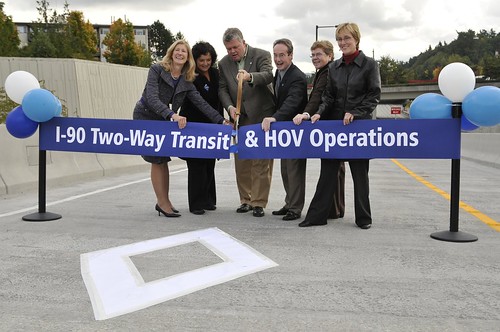DOT moves U.S. High-Speed Rail closer to reality; Interim Guidance to States Define High-Speed Rail: ‘Reasonably Expected to Reach … 110 MPH’
(Source: Streetsblog)
The federal DOT has just released its guidance for states seeking a share of its $8 billion in high-speed rail funding — and tucked in the rules are standards that could prove crucial to the project’s success.
The definition of high-speed rail can vary depending on the source. The original White House outline cited a top speed of 150 mph, while European and Asian networks can go as high as 200 mph. Today’s DOT guidance uses the same standard that was outlined in last year’s Amtrak reauthorization bill: high-speed trains are those “reasonably expected to reach speeds of at least 110 mph.”
That standard appears flexible enough to include most regional rail plans. California’s high-speed authority believes the state’s service can reach a top speed of 220pm. The states working on a midwestern rail network with Chicago at the center, however, envision their trains achieving an average of 67 mph for local service and 78 mph for express rides.
- 1.6.1 Track 1 – Intercity Passenger Rail Projects funded under ARRA (“Track 1 – Projects”)
- 1.6.2 Track 2 – High-Speed Rail/ Intercity Passenger Rail Service Development Programs (“Track 2 – Programs”)
- 1.6.3 Track 3 – Service Planning Activities funded under the FY 2009 and FY 2008 DOT Appropriations Acts (“Track 3 – Planning”)
- 1.6.4 Track 4 – FY2009 Appropriations-Funded Projects (“Track 4 – FY2009 Appropriations Projects”)
The dense nature of today’s 68-page guidance may make it difficult for many in the mainstream media to pay close attention. Yet with $8 billion on the line, it should be interesting to see how many state and local officials weigh in before DOT’s official comment period ends on July 10.
Secretary LaHood observed the following on his blog:
“And now, the time has finally come for the United States to get serious about building a national network of high-speed rail corridors we can all be proud of. A robust 21st Century economy requires efficient transportation of people from urban center to urban center. And, the guidance we publish today will evaluate proposals for their ability to:
- Make trips quicker and more convenient;
- Reduce congestion on highways and at airports; and
- Meet other environmental, energy and safety goals.
So, today the guidance; in mid-September we’ll be back with the first round of grant awards. I am proud to say the DOT is meeting its ARRA commitments and meeting them responsibly.
High-speed rail can reduce traffic congestion on the roads and in the skies, and it links conveniently with light rail, subways and buses for competitive door-to-door travel times. It will encourage economic growth and create new domestic jobs even as it makes our communities more livable.
The guidelines require rigorous financial and environmental planning to make sure projects are worthy of investment and likely to be successful. Both planning and construction are eligible, so states can apply for funds no matter what stage of development their project is in. ”
Click here to read the entire Streetsblog post.










